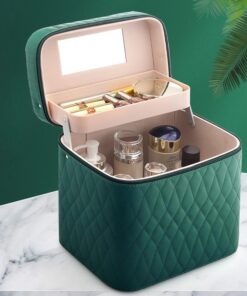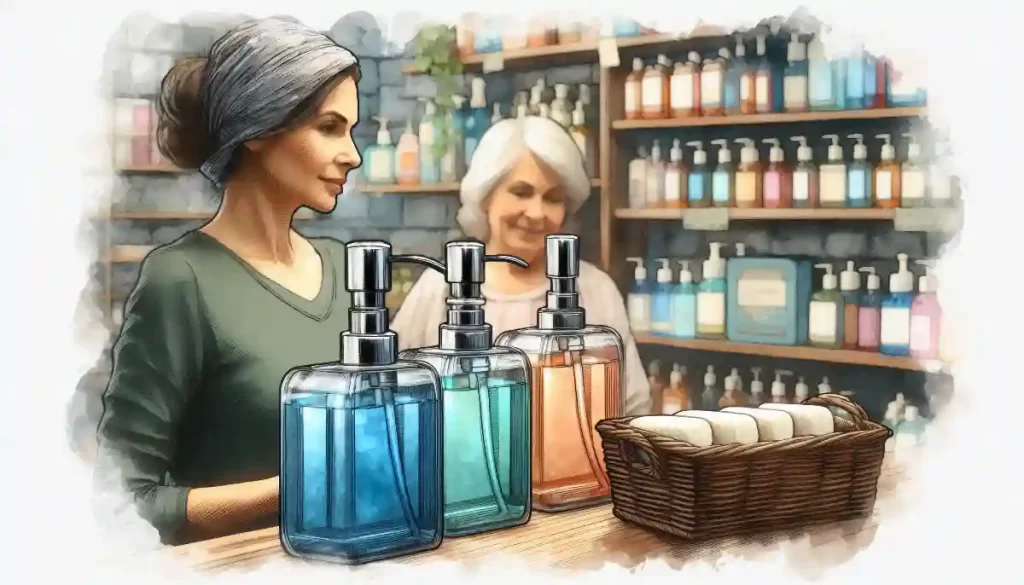Soap Dispensers
Practical Guide to Soap Dispensers: History, Design & Trends
Table of Contents
Introduction
Soap dispensers have become an indispensable part of modern hygiene, making handwashing easier, faster, and more sanitary. Once limited to basic pump mechanisms in public washrooms, soap dispensers are now available in countless designs, from elegant countertop models to automatic soap dispensers with built-in sensors. They not only reduce the spread of germs but also influence how people interact with hygiene products in homes, offices, and public spaces.
The appeal of today’s soap dispenser design trends lies in their combination of functionality, aesthetics, and innovation. What began as a simple solution to replace shared bars of soap has evolved into a global industry, with styles ranging from eco-friendly refillable bottles to smart touchless soap dispensers powered by sensors and batteries. Understanding how these devices developed provides insight into both hygiene habits and consumer expectations.
This practical guide explores the history of soap dispensers, their technological advancements, design evolution, and even the future of soap dispensers in a world increasingly focused on sustainability and health (United Nations Environment Programme, 2022). By the end, you’ll not only know how these tools transformed daily life but also how to choose dispensers that suit your space, values, and style.
History of Soap Dispensers
The history of soap dispensers is closely tied to the rise of liquid soap in the 19th and 20th centuries. Before dispensers became commonplace, handwashing was done almost exclusively with bar soap, which was shared among family members or even strangers in public places. While effective for cleaning, shared bar soap raised hygiene concerns, as bacteria and dirt could easily be transferred from one person to another.
Early Innovations (Late 19th – Early 20th Century)
The earliest soap dispensers were simple, gravity-fed devices made of glass or metal, designed to release liquid soap in measured amounts. They were most often found in commercial or public settings, like factories or train stations, where bar soap was impractical. These early models focused on function rather than style, and were too bulky for household use.
Growth of Liquid Soap (Mid-20th Century)
The real turning point came in the mid-20th century, when liquid soap gained popularity in homes and businesses. This shift made soap dispensers more practical and desirable, as liquid formulations required a delivery system that was clean, efficient, and easy to refill. By the 1950s and 1960s, companies began producing manual pump dispensers, which soon became a staple in kitchens and bathrooms.
Mainstream Adoption (1970s – 1980s)
By the 1970s, soap dispensers had firmly entered both residential and commercial environments. Schools, hospitals, and restaurants increasingly adopted them as part of broader hygiene initiatives. The design emphasis also began to shift, no longer just utilitarian, dispensers became more compact, stylish, and consumer-friendly.
Rise of Automatic and Touchless Models (1980s – Present)
The late 20th century introduced a new era of innovation: automatic soap dispensers. Using motion sensors, these devices allowed users to receive soap without touching the pump, dramatically reducing the risk of cross-contamination. Touchless soap dispensers quickly became popular in hospitals, where sterile environments are critical, and later spread to airports, schools, and homes.
Today, both manual and electronic dispensers coexist, but the emphasis has shifted toward hygiene, convenience, and design. Modern soap dispenser design trends not only prioritize sanitation but also sustainability, with refillable containers, biodegradable materials, and minimalist aesthetics appealing to eco-conscious consumers.
Technological Advancements in Soap Dispensers
The journey from manual pumps to automatic soap dispensers has been shaped by constant innovation. Technology has not only improved hygiene but also redefined the way people experience handwashing in homes, workplaces, and public spaces.
Manual Dispensers: The Starting Point
The earliest widely adopted soap dispensers were manual pumps. Users pressed down on a lever or button to release a controlled portion of liquid soap. While functional and reliable, manual dispensers still required physical contact. This meant that in public places, the dispenser itself could become a breeding ground for bacteria, undermining the very purpose of promoting hygiene.
Rise of Automatic Soap Dispensers
The 1980s marked a turning point with the introduction of automatic soap dispensers. Equipped with motion sensors, these devices allowed soap to be dispensed without physical contact. This touch-free mechanism was revolutionary in healthcare and food-service industries, where avoiding cross-contamination is critical. Hospitals, in particular, embraced touchless soap dispensers as part of infection-control protocols.
Over the years, sensor technology has become more accurate and reliable. Early models often dispensed either too much or too little soap, but modern versions can be adjusted to control flow, portion size, and sensitivity. Some are battery-powered, while newer designs integrate rechargeable systems to reduce waste.
Integration with Smart Technology
The latest soap dispenser design trends are increasingly influenced by smart technology. IoT-enabled dispensers can track usage data, monitor soap levels, and even send alerts when refills are needed. In commercial settings such as airports or hospitals, facility managers can monitor dozens of dispensers remotely, ensuring hygiene stations are alwaysstocked and functional.
Materials and Durability
Technological progress hasn’t just been about sensors. The materials used in soap dispensers have also evolved. Early metal designs corroded easily when exposed to moisture. Today, stainless steel, high-quality plastics, and even-tempered glass are common, balancing durability with aesthetics. Some modern touchless soap dispensers are coated with antimicrobial finishes to further reduce bacterial buildup.
Eco-Friendly Advances
Sustainability has become a driving force in the future of soap dispensers. Many new designs are compatible with refill packs, reducing single-use plastic waste. Some companies are experimenting with biodegradable casings and energy-efficient sensors that conserve battery life. These eco-conscious innovations align with broader consumer demand for greener hygiene solutions.
Trends in Soap Dispenser Design and Functionality
As hygiene became central to both public health and interior aesthetics, soap dispenser design trends have shifted dramatically. Once purely utilitarian, today’s dispensers combine convenience, innovation, and visual appeal, blending seamlessly into homes, offices, restaurants, and hospitals.
Minimalist and Modern Aesthetics
A key trend in soap dispensers is minimalism. Sleek, streamlined silhouettes with clean finishes, such as matte black, brushed steel, or frosted glass, now dominate bathrooms and kitchens. These designs are intended to complement a wide range of interior styles, from contemporary apartments to rustic farmhouse kitchens. The goal is to make dispensers functional while also elevating the overall space.
Customization and Personalization
Another growing element in soap dispenser design trends is personalization. Consumers can now choose from a wide palette of colors, materials, and finishes to match their decor. Some brands even offer engraving or logo printing, making them popular in boutique hotels, spas, or corporate spaces. This shift reflects a broader consumer demand for hygiene products that are not just practical but also tailored to personal or brand identity.
Functionality Beyond Soap
The functionality of soap dispensers has expanded in recent years. Many models now feature dual chambers, allowing them to dispense both soap and hand sanitizer, or even soap and lotion, from the same unit. Others are equipped with refill indicators or transparent windows that make it easy to monitor supply levels. These features reduce guesswork and improve user convenience, especially in high-traffic environments.
Eco-Friendly and Sustainable Features
Sustainability is shaping the future of soap dispensers. Refillable containers, biodegradable cartridges, and compatibility with concentrated soap solutions are increasingly popular. By encouraging users to refill instead of replace, manufacturers are reducing single-use plastic waste. Some automatic soap dispensers even feature rechargeable batteries or solar-powered sensors, further aligning hygiene with eco-conscious living.
Advanced Hygiene Innovations
The COVID-19 pandemic accelerated the demand for touchless soap dispensers, and they continue to dominate design innovation. Manufacturers are experimenting with antimicrobial coatings, UV sterilization features, and adjustable dispensing settings to ensure hygiene is maintained in every use. These upgrades highlight how soap dispenser design trends are being shaped by global health priorities as much as by style preferences.
Balance of Luxury and Function
In premium markets, soap dispensers are increasingly being treated as statement pieces. High-end hotels and restaurants may feature dispensers crafted from marble, ceramic, or wood, merging artistry with hygiene. At the same time, functionality remains a priority, proving that modern soap dispenser design trends are about balancing luxury with everyday practicality.
Impact of Soap Dispensers on Handwashing Habits
The introduction of modern soap dispensers has transformed how people approach hand hygiene. Before liquid soap and dispensing systems became widespread, bar soap was the standard. While effective for cleaning, shared bars often harbored bacteria and discouraged frequent use, especially in public restrooms. The arrival of liquid soap paired with soap dispensers made handwashing faster, more sanitary, and far more appealing.
Shifting from Bar Soap to Liquid Soap
The adoption of liquid soap in the 20th century was a major turning point. With the rise of convenient pumps and later automatic soap dispensers, people could quickly and hygienically clean their hands without worrying about contamination from shared surfaces. Public restrooms, schools, and hospitals in particular saw dramatic improvements in hygiene compliance once dispensers became commonplace.
Encouraging Frequent Handwashing
Studies have shown that the presence of touchless soap dispensers significantly increases the likelihood that people will wash their hands after using the restroom (Gupta et al., 2019). The simple act of removing the need to touch a pump or bar of soap reduces perceived barriers and makes handwashing more convenient. This behavioral nudge has been especially impactful in environments where high compliance is critical, such as food service industries and healthcare facilities.
Public Health and COVID-19
The COVID-19 pandemic brought renewed global attention to the role of soap dispensers in infection prevention. Demand for touchless soap dispensers soared, as businesses and households sought ways to reduce surface contact and promote safer hand hygiene. Campaigns by organizations like the World Health Organization highlighted how proper dispenser access and placement could reduce viral spread and protect communities (WHO, 2020).
Behavioral Design and Compliance
Modern soap dispenser design trends emphasize not only aesthetics but also behavioral science. Transparent windows that show soap levels, strategically placed dispensers in high-traffic areas, and designs that dispense the right amount of soap all encourage more consistent handwashing. In many workplaces and schools, compliance rose when dispensers were made more visible and easier to use.
Long-Term Impact on Hygiene Culture
The influence of soap dispensers extends beyond convenience; they have reshaped cultural norms around cleanliness. Where handwashing might once have been irregular, it is now widely viewed as an essential habit, reinforced by the accessibility of dispensers. The ongoing future of soap dispensers lies not just in technology but in how these tools continue to drive long-lasting hygiene behaviors in societies worldwide.
Future of Soap Dispensers: Innovation and Sustainability
As technology, design, and health priorities continue to evolve, the future of soap dispensers looks increasingly advanced, eco-conscious, and user-centered. No longer just basic hygiene tools, dispensers are becoming integrated into broader systems of smart living and sustainable design.
Smart Technology and IoT Integration
One of the most exciting developments in the future of soap dispensers is their integration with smart technology. IoT-enabled automatic soap dispensers are already appearing in hospitals, schools, and airports, where facility managers can remotely track usage levels and receive alerts when refills are needed. This reduces downtime, improves efficiency, and ensures that hygiene stations are always functional. In homes, connected touchless soap dispensers may soon sync with apps to track soap consumption, help families reduce waste, or even remind children to wash their hands.
Sustainability and Eco-Friendly Design
Environmental responsibility is shaping the latest soap dispenser design trends. Refillable cartridges are replacing single-use containers, while some brands are experimenting with biodegradable plastics and recycled materials. Others are exploring concentrated soap formulas that use less packaging, encouraging consumers to refill rather than replace. Solar-powered automatic soap dispensers and rechargeable models are also gaining popularity, cutting down on disposable batteries and energy waste.
Customization and Personalization
The future of soap dispensers will likely see even more emphasis on customization. Modular designs may allow users to swap out colors, finishes, or outer casings to match evolving decor styles. Commercial businesses may adopt customizable branding features, with engraved logos or themed exteriors. This aligns with the growing consumer desire for personalized products that combine functionality with self-expression.
Expanded Hygiene Capabilities
Advancements are also expected to expand the functionality of soap dispensers beyond soap. Some models already combine soap and sanitizer in dual chambers; future iterations may include multipurpose stations that dispense lotion, moisturizer, or even antibacterial wipes. Innovative prototypes include voice-activated or motion-sensitive dispensers with built-in UV lights that sanitize the nozzle between uses, a feature that aligns with the demand for safer, more hygienic public spaces.
Behavioral Nudges and Public Health
Looking forward, touchless soap dispensers may integrate prompts or feedback mechanisms to encourage better hygiene. Visual indicators, audio reminders, or LED countdown timers could remind users to wash hands for the recommended 20 seconds. By blending technology with behavioral science, these designs could further boost compliance and reduce the spread of disease.
Global Accessibility and Equity
Finally, the future of soap dispensers will likely involve greater focus on accessibility. Affordable, durable models designed for schools and low-resource settings are critical in expanding hygiene access worldwide. Nonprofit and commercial collaborations may help deliver sustainable soap dispensers to regions where proper handwashing infrastructure is still limited, reinforcing the role of dispensers as public health tools as much as consumer products.
Conclusion
The story of soap dispensers is more than just about convenience, it is a history of design, hygiene, and innovation that continues to shape how we live today. From their early use as basic manual pumps to the widespread adoption of automatic soap dispensers in healthcare and public spaces, they have steadily redefined handwashing habits andpublic health.
The rise of touchless soap dispensers has been especially significant, particularly during global health crises such as the COVID-19 pandemic, when reducing cross-contamination became critical (World Health Organization, 2020). Advances in soap dispenser design trends have also shifted the role of dispensers from plain utility objects to essential elements of home and workplace aesthetics (Kim & Lee, 2021). At the same time, sustainability and smart technology are transforming the future of soap dispensers, making them more eco-friendly, customizable, and connected than ever before.
By tracing this journey, it becomes clear that soap dispensers are not static objects. They are evolving tools that merge health, technology, and culture, adapting to meet new challenges while supporting the timeless practice of handwashing. Whether through advanced automatic soap dispensers with IoT capabilities, eco-conscious refill systems, or luxury models crafted to complement interiors, the humble dispenser has proven itself indispensable in modern society.
Ultimately, the future of soap dispensers lies in balancing innovation with accessibility. As global demand for effective hand hygiene continues to rise, dispensers will remain central to protecting health, reducing waste, and even shaping behavior. What began as a simple gadget to dispense liquid soap has become a powerful cultural and technological symbol, one that ensures the practice of handwashing remains both effective and enduring.
FAQs – Practical Guide to Soap Dispensers: History, Design & Trends
1. What were the earliest soap dispensers like?
Early soap dispensers were simple gravity-fed devices made from metal or glass, primarily used in public restrooms and commercial settings. They were often bulky and not commonly found in homes.
2. How have touchless soap dispensers impacted hygiene?
Touchless soap dispensers have drastically improved hygiene by reducing the need for physical contact, thereby minimizing the risk of cross-contamination. This has made handwashing safer and more appealing, especially in public spaces.
3. What materials are modern soap dispensers made from?
Modern soap dispensers are typically made from durable materials such as stainless steel, plastic, or high-quality glass. These materials ensure longevity, ease of maintenance, and resistance to corrosion.
4. What future developments can we expect in soap dispensers?
Future soap dispensers may integrate smart technology, use environmentally friendly materials, and offer advanced features like voice activation or built-in sanitizing lights. There could also be a focus on sustainability and customization.
5. How did the COVID-19 pandemic influence the use of soap dispensers?
The COVID-19 pandemic increased awareness of the importance of hand hygiene, leading to a surge in demand for soap dispensers, particularly touchless models. Public awareness campaigns also emphasized their role in preventing the spread of viruses, leading to wider adoption in homes and businesses.
References
Gupta, A., Kapil, A., Lodha, R., & Sreenivas, V. (2019). Evaluation of compliance to hand hygiene in a tertiary care hospital using an electronic dispenser monitoring system. Indian Journal of Medical Research, 149(6), 688–693. https://doi.org/10.4103/ijmr.IJMR_1917_17
Kim, J., & Lee, H. (2021). Consumer preference for product design: Aesthetic minimalism in household items. Journal of Design Research, 19(4), 321–339. https://doi.org/10.1504/JDR.2021.119887
United Nations Environment Programme. (2022). Sustainability and circular economy in consumer products. UNEP. https://www.unep.org/resources/report/sustainability-and-circular-economy
World Health Organization. (2020). Hand hygiene for all: Scaling up hand hygiene in response to COVID-19. WHO. https://www.who.int/publications/i/item/9789240011602


 Two-Tier Cosmetic Organizer - Portable Beauty Storage Box with Trays
Two-Tier Cosmetic Organizer - Portable Beauty Storage Box with Trays  Travel-Friendly Cosmetic Box - Durable and Elegant Design
Travel-Friendly Cosmetic Box - Durable and Elegant Design 